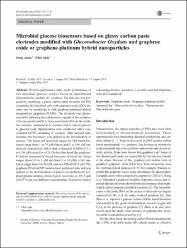Microbial glucose biosensors based on glassy carbon paste electrodes modified with Gluconobacter Oxydans and graphene oxide or graphene-platinum hybrid nanoparticles
Abstract
We have performed a study on the performance of two microbial glucose sensors based on immobilized Gluconobacter oxydans (G. oxydans). The first one was prepared by modifying a glassy carbon paste electrode (GCPE) containing the microbial cells with graphene oxide (GO), the other one by modifying it with graphene-platinum hybrid nanoparticles (graphene-Pt NPs). The electrode was characterized by following the voltammetric signals of the oxidation of hexacyanoferrate(II) to hexacyanoferrate(III) via the oxidative enzymes contained in G. oxydans which convert glucose to gluconic acid. Optimizations were conducted with a conventional GCPE containing G. oxydans. After material optimization, the biosensors were applied to the determination of glucose. The linear and analytical ranges for GO based biosensor range from 1 to 75 mu M (linear) and 1 to 100 mu M (analytical), respectively, with a limit of detection (LOD) of (3 s/m) 1.06 mu M (at an S/m of 3). On the other hand, the graphene-Pt hybrid nanoparticle based biosensor showed two linear ranges (from 0.3 to 1 A mu M and from 1 to 10 mu M), a full analytical range from 1 to 50 mu M, and an LOD of 0.015 mu M. The graphene-Pt hybrid NP based sensors performs better and was applied to the determination of glucose in synthetically prepared plasma samples where it gave recoveries as 101.8 and 104.37 % for two different concentrations. Selectivity studies concerning fructose, galactose, L-ascorbic acid and dopamine were also conducted.


















